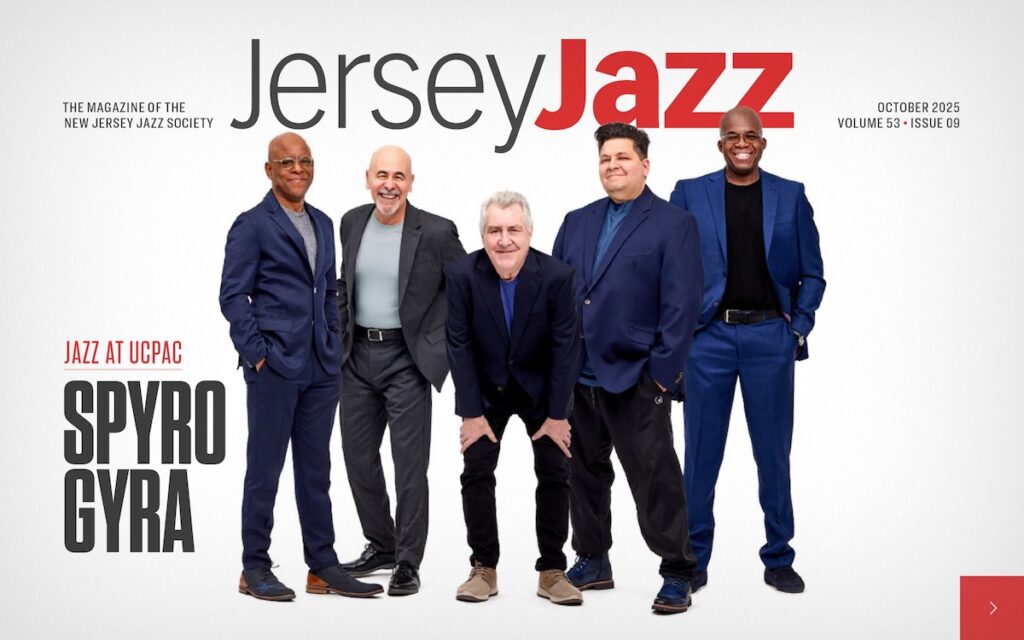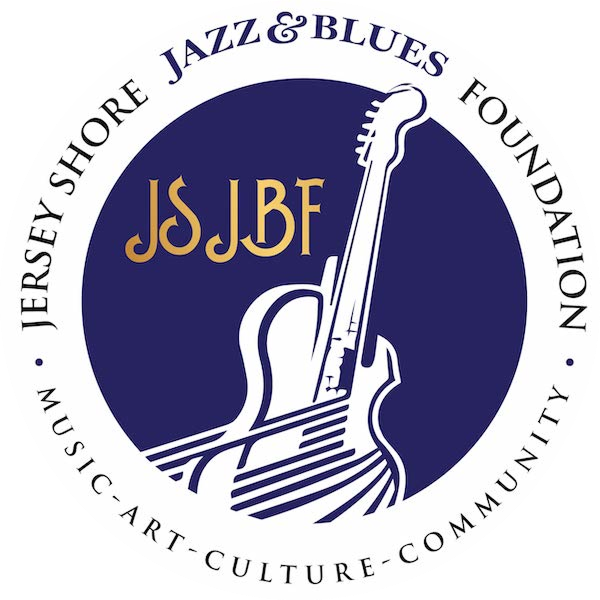Jazz Blended with R&B, Latin, and Carribean Influences

by Jay Sweet
Initially published in New Jersey Jazz Society www.njjs.org
Spyro Gyra has enjoyed a 50-plus year run by presenting instrumental music that blends jazz, R&B, Latin, and Caribbean influences. Along the way, the band had hits such as “Morning Dance”, “Shaker Song”, and “Catching the Sun”, which remain concert favorites and will be featured on their current tour, which includes a performance at the Union County Performing Arts Center in Rahway, NJ, on November 1, as part of WBGO Radio’s All That Jazz series.
Much of the band’s longevity comes not only from its high-quality, accessible music but also from the efforts of its founder and leader, saxophonist and composer Jay Beckenstein, who reflected on how the group has endured shifting music trends and lineup changes.
“There are many reasons for our longevity,” he said. “For one, we’ve always played well. And we’ve kept things alive by staying on the road, constantly touring, never stopping. What we avoided were the usual internal conflicts. I kept great talent in the band, and I’ve always been able to do that by not treating it like ‘my’ band. Everybody gets to write, everybody gets a say, and everybody gets featured in the shows.” That’s why,” It’s not called the Jay Beckenstein Band.”
Beckenstein likes to compare the band to a basketball team. “We’re not a band with one guy sitting under the basket dunking and everybody else passing to him. We pass the ball around a lot. But when the moment comes where ultimate control is needed to prevent the whole thing from breaking up—that’s where I stand. There has to be authority. There simply has to be. That same meritocracy that brings great musicians into the band only works if someone is there to step in when a rotten apple could ruin it for everyone.”
His path into music began early. “I grew up on Long Island and lived there until I was 16. (His family then moved to Germany to follow his father’s job offer). I was raised in a household where jazz was constantly playing, so I was well indoctrinated into the music before I was even four years old. I started on the saxophone at age six through my elementary school band program in Farmingdale.”
Beckenstein’s father had “the most magnificent record collection. He was always introducing me to music. I remember being seven or eight years old when he brought home albums like Miles Davis’ Kind of Blue, and Birth of the Cool and Charles Mingus records.Those recordings were my teachers, because I never really had a great private instructor growing up. I learned by listening, absorbing, and playing along. My father was also a keyboard player, and even
before I turned five, he’d have me sit on the right side of the piano while he laid down boogie-woogie bass lines.
My household,” he continued, “was almost entirely classical and jazz. My first real step outside of that world was when I started secretly listening to the Beatles under the covers at night, tuning into WABC Radio in New York. I must have been 12 or 13, quietly soaking up pop music without anyone knowing. Growing up when I did—in the ’50s and ’60s, and then into my 20s in the ’70s—you couldn’t ask for three better decades musically. The jazz scene was incredible, and pop music was being invented in real time. It was an extraordinary time to come of age musically.”
His introduction to live jazz came through “this program where musicians would come and play outdoor concerts for school kids. Through that, I got to see some incredible artists: Miles Davis, and Joe Zawinul playing with Cannonball. I was exposed to some of the greatest musicians when I was still very young. As soon as I was able, I started going into the city on my own. My favorite group to see was the Thad Jones–Mel Lewis Orchestra. That band was just unbelievable, with players like Eddie Daniels and Jerome Richardson.”
That foundation would deepen dramatically when his family relocated to Germany. “Attending a military dependents’ school, I started playing music with soldiers. I joined a band with three master sergeants, performing in NCO clubs, and that was my introduction to R&B. These were Black soldiers, and we were playing songs like “Sittin’ on the Dock of the Bay”. Playing with them opened me up to a whole new world of music. When I eventually returned to the States, I added Stevie Wonder, Marvin Gaye, and other early R&B artists to my palette, and they became lasting influences”.
Beckenstein returned to the U.S. to attend the University of Buffalo. “I didn’t originally go for music. In fact, my parents wouldn’t allow it. My first year I studied biology and medicine, which is where I first came across the word spirogyra (fresh-water green algae). By my second year I had switched to English, and by the third year I had more or less ‘devolved’ academically into a music major because it turned out that was the only thing I really did well.
“The program was very classical, but the scene in Buffalo at that time was dominated by new music: wild, experimental, atonal pieces with graphic notation and all sorts of avant-garde ideas. I played with a group called SEM, which included musicians from the Buffalo Philharmonic, and I was good enough to be brought into their ensemble. We performed some truly crazy works.
“I soon found myself in a great blues band, literally the opposite of what I had just been doing. I had gone from music that was completely mental, with no heart, to music that was all body and pure feeling. I remember playing the blues for the first time and getting goosebumps, thinking, ‘Oh man, this is what music is supposed to feel like.’ That was my introduction to the Buffalo music scene.”
The band was led by Elmo Witherspoon, “a powerful blues vocalist backed by strong musicians. The music wasn’t complicated, but it was full of depth and soul. That experience taught me so much—about per formance, about feeling, about connecting with an audience. I worked in that Buffalo scene for two or three years, playing in horn sections, working with R&B bands, and gradually making my way as a musician.”
After graduation, Beckenstein stayed in Buffalo and became further immersed in the music scene, where Spyro Gyra formed almost organically. “I worked with a group called the Buffalo Jazz Ensemble, which was the brilliant idea of my mentor, tenor player Phil DeRay. In the early ’70s, Buffalo was still reeling from the terrible racial riots in the wake of Martin Luther King’s assassination. The city was racially polarized, tense, and hurting. Phil had the remarkable idea to address it through music. He actually applied to FEMA for funding, arguing that the racial situation in Buffalo was, in its own way, a disaster. Incredibly, he got the grant.
“The Buffalo Jazz Ensemble was built on a simple but powerful principle: it was half African- American musicians and half white musicians. We toured both Black and white neighborhoods, trying in our own way to bring a little healing, a little love, through jazz. It was an extraordinary experience, and many of the musicians I later played with in Spyro Gyra were people I first met in that ensemble.”
The band itself began taking shape in the Buffalo clubs around 1974 and ’75. By 1976, Beckenstein had gone into business with Richard Calandra, producing all kinds of commercial projects—disco, rock, rockabilly—for local Buffalo artists. They rented a studio and whenever time remained at the end of a session, Beckenstein would use it to record Spyro Gyra.
“The production company was going nowhere,” he remembered, “and the players in the band were getting ready to leave Buffalo for New York, L.A., maybe Nashville. What we didn’t realize was that in those spare sessions, I had put together a whole record’s worth of Spyro Gyra material. It was, in effect, a farewell record—utterly self-produced, naïve, and made without any expectations. We thought we were saying goodbye.”
Instead, the record took on a life of its own. The initial 500 copies sold out almost immediately, and local radio gave it a spin. When the band approached Lenny Silver, owner of the Record Theater chain, he agreed to take 50 copies. They sold in a day. The next week he wanted 100. Then 500. Finally, he offered the band a contract. “For me, a little hippie kid in Buffalo, it was an obscene amount of money. I signed my life away, but to Lenny’s credit, he poured energy and resources into promoting that first record, and it sold 100,000 copies.”(The album, Spyro Gyra, reached No. 99 on Billboard’s Top 200 Albums chart.. “Shaker Song” reached Number 16 on the Adult Contemporary singles chart and Number 90 on the Hot 100 singles chart).
By the time of the band’s second release, Morning Dance, the stakes had risen. Silver realized the band was getting too big for him to handle, so he sold the contract to MCA Records. Spyro Gyra was placed on MCA’s new subsidiary, Infinity Records. “It was a strange outfit. They were trying to build a major rock label, signing acts left and right But the label collapsed. Ironically, the little jazz group they had picked up almost as a favor ended up being the one that took off. Morning Dance went platinum, and suddenly we were the only thing selling on Infinity. That meant we got all their promotional push and before long we were getting rock star treatment. The album launched like a rocket. I never thought it was unusual for an instrumental band to reach that level; I just thought it was unusual that it was us. But it was really a perfect storm of good fortune, timing, and opportunity that launched Spyro Gyra.”
Later, in his late 20s, Beckenstein experienced one of his personal career highlights: touring with Miles Davis. “To describe my impression of
Miles—let’s just say complex. He was simultaneously the greatest musician I grew up with and, at the same time, a pretty tough personality. My father had raised me on Miles music. The highlight of every year was when he’d bring home the newest Miles record. So, I grew up worshipping Miles. To me, he was the greatest creator, always moving forward, never sitting on his laurels, producing one brilliant new idea after another.
“Then suddenly, we found ourselves as his warmup band, probably around 1981. By that time, Miles had become quite the curmudgeon. He was limping around and not exactly cheerful. Still, we went out of our way to ingratiate ourselves. At every concert—even though he never said hello—we’d send him a big bouquet of flowers with a note thanking him for everything he had given us. By the third concert, at Red Rocks in Colorado, we were in our dressing room when the door cracked open. There was Miles. He looked at us and said only, ‘Spiro Gyra! Okay.’ For me, it was like being blessed by the Pope.”
Decades later, after years of recording and touring, Beckenstein remains energized by what lies ahead. “The next project we’re working on is a documentary about the band with a company in Hollywood. It’ll be a four-part series, each episode an hour long. They’ve already been filming shows, and we’ve got some really strong performances recorded on multitrack. I think the next release will probably be a live concert to go along with the documentary.”
Judging by the vitality of its recent recordings and the continued enthusiasm of audiences, it seems clear that, like the living organism from which the group takes its name, Spyro Gyra will continue to grow and flourish.
